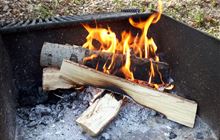Stay fire safe in the outdoors this summer holidays
Archived content: This media release was accurate on the date of publication.
Introduction
People heading into the outdoors during the holiday season are reminded to be fire safe to protect native species and cultural heritage sites from devastating wildfires.Date: 20 December 2022
DOC National Fire Manager Aroha Hughes says its essential that people check whether fires are allowed in the area, and the fire status for the region, before lighting fires in the outdoors.
“The day you head out on your trip, go to the Check it's alright website first to follow the fire safety advice and to check the local fire danger level. This tool will tell you whether it’s ok to light a fire.”
Aroha says conservation land is always in a restricted or prohibited fire season, depending on the fire risk – and some areas have a year-round total fire ban.
“If the area is in a restricted fire season, it means people may light fires at a campsite’s designated fireplace, or in the backcountry according to specific conditions, which are outlined on the DOC website’s lighting fires on public conservation land page. Care should be taken to thoroughly extinguish any campfires before leaving a site,” she says.
“If it’s a prohibited fire season, it means there is a fire ban and no fires can be lit, though fireplaces inside huts can still be used.
“There may also be useful fire safety information on the DOC webpage about the specific track, hut or campsite being visited.”
Aroha says disposing of hot ashes outside can start devastating wildfires, so ashes from hut fireplaces should be put into the metal bins provided at huts and then soaked with water.
“Gas cookers and enclosed liquid fuel stoves can usually be used at any time, but extra care should be taken if the fire risk is high. Set them up in an area that’s at least 3 m clear of any vegetation on a stable, level surface, and be careful when balancing heavy pots on top as they could tip the cooker over.”
“Another thing to think about is where to park the car at the start of a trip, as a hot exhaust in long grass can start a fire.”
Aroha says that with the exception of parts of Canterbury, Otago and Southland, the fire risk across the country is lower than normal for this time of year. However, as we saw with the Mt Creighton and Lake Tekapo fires this year, conditions don’t always need to be extreme for damaging wildfires to occur. That’s why it’s important to visit Check it's alright on the day of a trip.
“Last season, wildfires had a significant ecological and cultural impact at several sites across the country, including the Kaimaumau Wetland in Northland and the Awarua Wetlands near Invercargill.
“Fires on conservation land are often caused by people by accident. No one wants to see native ecosystems, recreation assets, or heritage and cultural sites destroyed because of a fire, so we’re asking people to stay fire safe in the outdoors this summer.”
Find out about local fire restrictions at the Check it's alright website.
Read more about lighting fires on public conservation land.
Background information
Rules for fires on public conservation land
Public conservation land is always in a Restricted or Prohibited fire season:
- Restricted fire season – means you may light fires at a campsite's designated fireplace, and in the backcountry according to the specific conditions.
- Prohibited fire season – means there is a fire ban and you can not light any fires on public conservation land (you can still use fireplaces inside DOC huts).
You can light campfires at DOC campsites or day amenity areas only if:
- There is no fire ban in place; and
- You use the designated fireplaces/fire pits.
You can light campfires in the backcountry only if:
- There is no fire ban in place;
- There are no notices prohibiting fires there;
- The fire is at least 3 metres away from trees and anything that could catch fire; and
- The fire is smaller than 0.5 m in width and in height.
Backcountry refers to areas that are more than an hour’s walk from the nearest road end.

